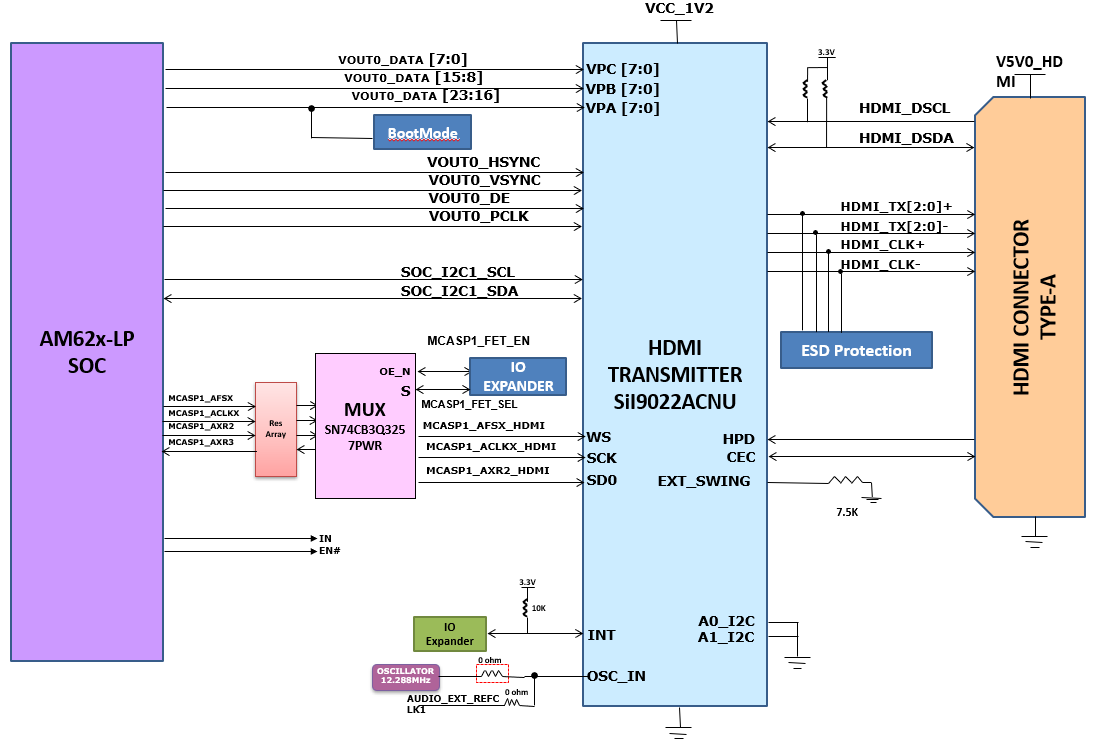SPRUJ51 june 2023
- 1
- 1Abstract
- 2EVM Revisions and Assembly Variants
- Trademarks
-
3System Description
- 3.1 Key Features
- 3.2 Functional Block Diagram
- 3.3 AM62x-Low Power SK EVM Interface Mapping
- 3.4 Power ON OFF Procedures
- 3.5
Peripheral and Major Component Description
- 3.5.1 Clocking
- 3.5.2 Reset
- 3.5.3 OLDI Display Interface
- 3.5.4 CSI Interface
- 3.5.5 Audio Codec Interface
- 3.5.6 HDMI Display Interface
- 3.5.7 JTAG Interface
- 3.5.8 Test Automation Header
- 3.5.9 UART Interface
- 3.5.10 USB Interface
- 3.5.11 Memory Interfaces
- 3.5.12 Ethernet Interface
- 3.5.13 GPIO Port Expander
- 3.5.14 GPIO Mapping
- 3.5.15 Power
- 3.5.16 AM62x-Low Power SK EVM User Setup and Configuration
- 3.5.17 Expansion Headers
- 3.5.18 Push Buttons
- 3.5.19 I2C Address Mapping
- 4Known Issues and Modifications
- 5Revision History
- 6IMPORTANT NOTICE AND DISCLAIMER
3.5.6 HDMI Display Interface
The DSS (Display Sub system) interface from AM62X 17x17 SoC is
used on the SK EVM to provide a HDMI Interface through a standard Type-A Connector. The SK EVM
features a SiI9022A HDMI Transmitter from Lattice semiconductors to convert the 24bit Parallel
RGB DSS output stream as well as a McASP to a HDMI-compliant digital audio and video signal.
The Data mapping format used is RGB888. The data bus width is 24-bits. SoC_I2C1 is connected
to the HDMI Transmitter accesses the compatible mode registers, the TPI registers, and the CPI
registers. In order to use the SiI9022A, the SoC needs to setup the device. This is done via
the I2C interface between the SoC and the SiI9022A. Audio Data is sent from SoC to HDMI
transmitter through the McASP1 instance. HDMI_I2C Bus accesses the EDID and HDCP data on an
attached sink device. TMDS Differential data pairs along with the differential clock signals
from the transmitter are connected to the HDMI connector through HDMI ESD device Mfr Part#
TPD12S016PWR which also acts as a load switch to limit current supplied to the HDMI connector
from board 5V supply. The HDMI Framer is powered using 3.3V Board IO Supply and 1.2V by a
dedicated PMIC LDO.
 Figure 3-12 HDMI Interface Block Diagram
Figure 3-12 HDMI Interface Block Diagram
 Figure 3-12 HDMI Interface Block Diagram
Figure 3-12 HDMI Interface Block Diagram